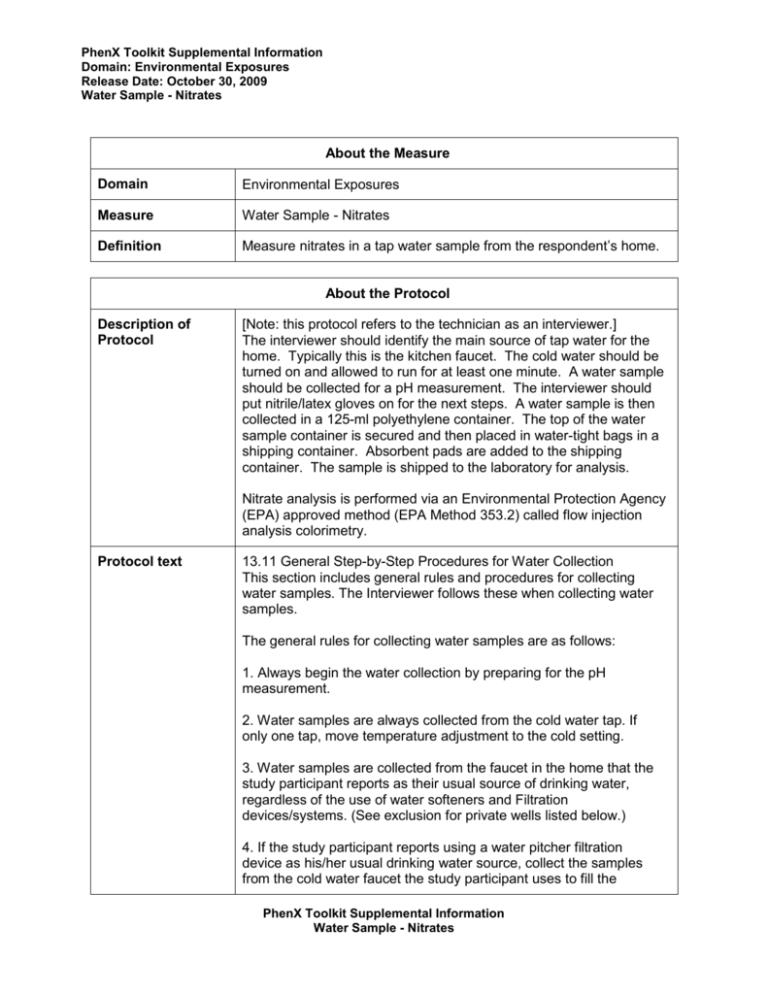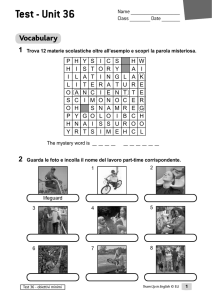Water Sample - Nitrates
advertisement

PhenX Toolkit Supplemental Information Domain: Environmental Exposures Release Date: October 30, 2009 Water Sample - Nitrates About the Measure Domain Environmental Exposures Measure Water Sample - Nitrates Definition Measure nitrates in a tap water sample from the respondent’s home. About the Protocol Description of Protocol [Note: this protocol refers to the technician as an interviewer.] The interviewer should identify the main source of tap water for the home. Typically this is the kitchen faucet. The cold water should be turned on and allowed to run for at least one minute. A water sample should be collected for a pH measurement. The interviewer should put nitrile/latex gloves on for the next steps. A water sample is then collected in a 125-ml polyethylene container. The top of the water sample container is secured and then placed in water-tight bags in a shipping container. Absorbent pads are added to the shipping container. The sample is shipped to the laboratory for analysis. Nitrate analysis is performed via an Environmental Protection Agency (EPA) approved method (EPA Method 353.2) called flow injection analysis colorimetry. Protocol text 13.11 General Step-by-Step Procedures for Water Collection This section includes general rules and procedures for collecting water samples. The Interviewer follows these when collecting water samples. The general rules for collecting water samples are as follows: 1. Always begin the water collection by preparing for the pH measurement. 2. Water samples are always collected from the cold water tap. If only one tap, move temperature adjustment to the cold setting. 3. Water samples are collected from the faucet in the home that the study participant reports as their usual source of drinking water, regardless of the use of water softeners and Filtration devices/systems. (See exclusion for private wells listed below.) 4. If the study participant reports using a water pitcher filtration device as his/her usual drinking water source, collect the samples from the cold water faucet the study participant uses to fill the PhenX Toolkit Supplemental Information Water Sample - Nitrates PhenX Toolkit Supplemental Information Domain: Environmental Exposures Release Date: October 30, 2009 Water Sample - Nitrates pitcher. 5. Water samples are collected from drinking water that comes from private wells according to the following collection rules: If two sources are used to collect water samples, each faucet is flushed for 1 minute. If two sources are used, record this. 6. If a filter is attached to the faucet, the Interviewer documents this and collects the samples. The Interviewer does not remove the filtration device. 7. If the faucet has an aerator, the Interviewer documents this and collects the samples. The Interviewer does not remove the aerator. 8. All collection containers are kept closed until ready to collect a sample to avoid the possibility of contaminating the sample. The Interviewer opens only one collection container at a time. S/he collects the sample, closes the container and then proceeds to open and collect the next sample if applicable. For each type of water collection, the Interviewer first completes these general procedures for collecting water samples: Check the faucet. If there are any aerators, strainers, hose attachments, and/or water devices that can easily be bypassed without the use of any tool or force, then bypass the system and collect the sample. If it is not easy to bypass the attachment, collect the sample at a different faucet. Do not attempt to disconnect any of these attachments. Do not collect any water sample from a faucet with an attachment or a faucet that is damaged. If there are dishes or other objects in the sink, ask permission and move them aside so that the drain is clear. Flush the water line by fully opening the cold water tap and allowing the water to flow for one minute. Use a timer to measure the one minute. Document the number of minutes the line was flushed. If the line could not be flushed, document this and proceed with the water collection. If the drain for the preferred water source is clogged, the Interviewer collects from a different source and records “Yes” to the question, “Were there any problems with the water collection procedures?” The “Yes” requires specification of the problem, so the Interviewer documents where the sample is collected and that the PhenX Toolkit Supplemental Information Water Sample - Nitrates PhenX Toolkit Supplemental Information Domain: Environmental Exposures Release Date: October 30, 2009 Water Sample - Nitrates original drain was clogged in that field. Open a plastic-lined towel and place it on a flat surface near the sink, such as a counter top or table. When ready to collect the samples after the one-minute flush, reduce the flow rate of the water to a slow steady stream to avoid splashing when filling the containers. When collecting water for the pH measurement, water is running from the source at a ‘slow fill’ rate. Collect the water for the pH measurement and submerse the pH strip. 13.12 Water pH measurement A measurement of the pH of water is taken from study participants whose primary source of drinking water is a private well and/or public water supply. Interviewers are responsible for collecting a sample of water and taking a measurement of the pH using the study-specific protocols described in the following section. Every study participant is eligible for water pH measurement, which is taken prior to the collection of any water samples. Always begin the water collection procedures with the pH water collection. 13.12.1 Equipment and Supplies Interviewers are provided with the following supplies: Reusable Beaker Water pH strips (Baker-pHIX, pH 4.5-10) pH color reference chart Absorbent lined chux Timer 13.12.2 Step-by-Step Procedures for Water pH Measurement The water sample for pH measurement is taken from the same faucet as the collected samples. It should be taken from the cold water faucet in the kitchen whenever possible. If the sample cannot be taken from the kitchen, the Interviewer collects water from a bathroom sink, using any cold water faucet without an attachment. The pH measurement of a separate water sample (other than those collected for shipment) precedes collection of the water samples as designated by the water collection protocol. The Interviewer rinses and dries the reusable beaker between interviews. Steps that the Interviewer should follow for measuring pH are as follows: 1. The Interviewer flushes water line using timer to measure one minute. The Interviewer sets up pH measurement materials and water collection materials while the line is flushed. PhenX Toolkit Supplemental Information Water Sample - Nitrates PhenX Toolkit Supplemental Information Domain: Environmental Exposures Release Date: October 30, 2009 Water Sample - Nitrates 2. After the line has been flushed, the Interviewer rinses the reusable pH measurement beaker three times with water from the flushed source. 3. The Interviewer collects approximately 60ml of water in the beaker. 4. The Interviewer places one pH strip in the water, with all three color blocks submerged, then starts the timer. 5. The color blocks must be submerged in the water for 10 minutes. 6. After the pH strip has been placed in the water and the timer has been set, the Interviewer proceeds to collect water samples according to study protocol. 7. Once ten minutes have elapsed, the Interviewer removes the strip from the water and immediately compares the strip to the color reference chart. 8. The Interviewer determines the pH number associated with the color blocks that correspond to the colors on the test strip and documents this. 9. The Interviewer discards the water in the sink and dries the reusable beaker. 10. If all water samples were not collected during the ten-minute interval, the Interviewer proceeds to complete collection of all water samples, otherwise, the Interviewer cleans the collection area and gathers any waste generated to discard it away from the study participant home. 13.16 Step-by-Step Procedures for Private –Nitrate Water Sample The nitrate sample is collected in a dark 125-ml polyethylene container. After completing the general collection steps listed in 13.11, the Interviewer proceeds with the following steps: 1. Put on a pair of disposable latex gloves and a disposable laboratory coat (if not already wearing). 2. Open the collection kit marked Private and remove all of the components included in the kit. 3. Place nitrate bottles (one 125-ml dark container) in an upright position. Place the transmittal forms away from the collection PhenX Toolkit Supplemental Information Water Sample - Nitrates PhenX Toolkit Supplemental Information Domain: Environmental Exposures Release Date: October 30, 2009 Water Sample - Nitrates location. This will eliminate the potential for spills onto the transmittal forms. 4. Do not remove the absorbent pads from the 6x10 and 10x10 watertight transport bags. 5. Confirm that the collection container and the Water Sample Repository Transmittal Form are labeled with the correct sample ID label. The Water Sample Repository Transmittal Form is also labeled with a PID. 6. When removing the cap from a sample bottle, be careful not to contaminate the cap or neck by contact with the fingers. Do not rinse the sample bottle. 7. Carefully open the bottle and fill to the top of the bottle’s ‘shoulder’, the point where it narrows, before it ends at the 'cone' where the cap is screwed. 8. Once all samples are collected, turn off the water supply. 9. Place the collected samples into the appropriate watertight bags. 10. The nitrate sample is packaged in the 10x10 watertight bag. Be sure to verify that an absorbent pad is included in the bag. 11. Remove as much air from each bag as possible prior to sealing. This can be accomplished by rolling the bag around the sample containers. 12. For each bag, remove the blue protective tape from the transport bag and seal. 13. For nitrate samples it is important to package the samples with frozen ice packs as soon as possible after collection. These samples must be maintained at 0° – 6°Celsius. 14. Document the results of water sample collection on the Water Sample Repository Transmittal Form (for the arsenic samples). 15. Be sure to clean the work area thoroughly. Wipe the area dry and clean up any spills. Discard the plastic-lined towel, gloves, and any paper towels into a small trash bag. Remove the trash bag from the study participant's house and discard it with the other waste from the visit. 16. Ship the samples according to the shipping protocol. PhenX Toolkit Supplemental Information Water Sample - Nitrates PhenX Toolkit Supplemental Information Domain: Environmental Exposures Release Date: October 30, 2009 Water Sample - Nitrates Participant Age 18+ Source New England Study of Environment and Health, Version 5 Interviewer Manual, Sections 13.11, 13.12, and 13.16, 2003 U.S. Environmental Protection Agency (EPA). 1993. Method 353.2: Determination of Nitrate-Nitrite Nitrogen by Automated Colorimetry. Retrieved on May 11, 2009, from http://www.epa.gov/waterscience/methods/method/files/353_2.pdf Language of Source English Personnel and Training Required A trained interviewer/technician collects the tap water sample and returns the sample to the laboratory for analysis. An adult from the residence could collect the tap water sample although this is not routinely done. A trained laboratory technician should perform all post-collection processing and analysis. The U.S. Environmental Protection Agency (EPA) standard method 353.2 for analysis of nitrates should be employed. Equipment Needs Water collection supplies are necessary to measure pH and collect the tap water sample for nitrate analysis. Laboratory instruments are necessary to perform flow injection analysis colorimetry on the sample. Tap water samples samples may be shipped to laboratories that specialize in these types of analysis. Protocol Type Laboratory Analysis General References None PhenX Toolkit Supplemental Information Water Sample - Nitrates







